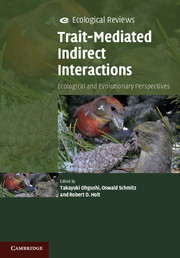Book contents
- Frontmatter
- Contents
- Contributors
- Foreword
- Preface
- Chapter One Introduction
- Part I Community
- Part II Coevolution
- Part III Ecosystem
- Part IV Applied Ecology
- Chapter Twenty-Two Perspective
- Chapter Twenty-Three Natural enemy functional identity, trait-mediated interactions and biological control
- Chapter Twenty-Four Trait-mediated effects modify patch-size density relationships in insect herbivores and parasitoids
- Chapter Twenty-Five Plasticity and trait-mediated indirect interactions among plants
- Chapter Twenty-Six Climate change, phenology and the nature of consumer–resource interactions
- Chapter Twenty-Seven Coda
- Index
- Plate Section
- References
Chapter Twenty-Five - Plasticity and trait-mediated indirect interactions among plants
Published online by Cambridge University Press: 05 February 2013
- Frontmatter
- Contents
- Contributors
- Foreword
- Preface
- Chapter One Introduction
- Part I Community
- Part II Coevolution
- Part III Ecosystem
- Part IV Applied Ecology
- Chapter Twenty-Two Perspective
- Chapter Twenty-Three Natural enemy functional identity, trait-mediated interactions and biological control
- Chapter Twenty-Four Trait-mediated effects modify patch-size density relationships in insect herbivores and parasitoids
- Chapter Twenty-Five Plasticity and trait-mediated indirect interactions among plants
- Chapter Twenty-Six Climate change, phenology and the nature of consumer–resource interactions
- Chapter Twenty-Seven Coda
- Index
- Plate Section
- References
Summary
Introduction
Ecologists have long recognized the importance of phenotypic plasticity as a mechanism by which organisms acclimate and adapt to local environments. Phenotypic plasticity is commonly defined as variation in the morphological or physiological phenotype of a given genotype in response to the abiotic and biotic environment (Bradshaw 1965). Plants are particularly plastic organisms because they must solve the fundamental problems of resource acquisition, competition and herbivore attack without mobility (Sultan 1987, 2000). Plasticity has been demonstrated in the morphological, developmental, physiological and biochemical traits of plant species, with many traits showing flexibility in expression both between and within individual plant species (Novoplansky 2002; de Kroon et al. 2005; Valladares et al. 2006). The plastic responses vary not only in their form, but also in their permanence. Responses may be permanent for the lifetime of an individual, fixed for long periods of time (e.g., a growing season), or dynamic at the scale of minutes (Metlen et al. 2009).
Research on the nature of plasticity and its potential to broaden the ecological niches of species in shifting abiotic and biotic conditions has historically focused on the morphological responses of plants. However, morphological responses tend to be slow and are largely irreversible – two parameters that are not favoured by selection (Valladares et al. 2007). In contrast to changes in morphology, plants can also respond via biochemistry. These responses can be exceptionally rapid and highly ephemeral (Metlen et al. 2009); traits that lend themselves to adaptive value and are favoured by natural selection, but biochemical traits have been studied very little in the explicit context of plasticity.
- Type
- Chapter
- Information
- Trait-Mediated Indirect InteractionsEcological and Evolutionary Perspectives, pp. 489 - 507Publisher: Cambridge University PressPrint publication year: 2012
References
- 2
- Cited by

